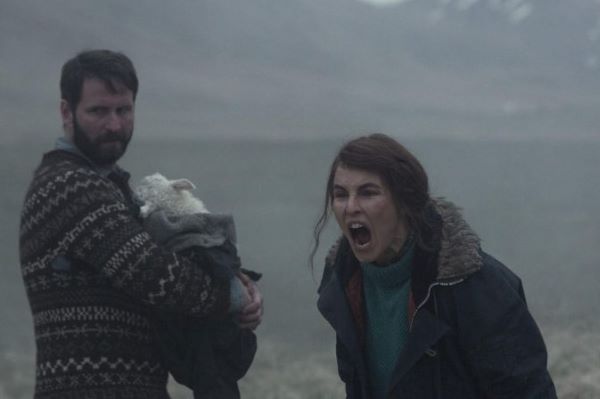“It’s oh so quiet,” sang Björk on her mega-hit cover of the same name back in 1995. Twenty six years later Iceland has unleashed another hush-hush artistic project onto the world in the form of Valdimar Jóhannsson’s debut feature Lamb, a film which is oh, so quiet and so peaceful until…
Starting life as a series of sketches, Lamb took several years to make its way to the big screen with Jóhannsson requiring the help of poet, novelist, and fellow countryman Sjón (co-writer on Robert Eggers’ upcoming The Northman) to turn his images first into concrete ideas, before being structured into the traditional story format that makes up the movie in it’s finished state. Speaking of “traditional”, the structure (which is divided into 3 chapters told in linear fashion) is pretty much the only aspect which falls neatly into this category.
Noomi Rapace and Hilmir Snær Guðnason play Maria and Ingvar respectively, two Icelandic sheep farmers who live in the cold shadow of the mountains, otherwise known as the middle of nowhere. Abandoned from the rest of the world, the couple work tirelessly to keep the farm running and to distract themselves from having to deal with a past tragedy. Of course, as is key for folk tales, such buried emotions will soon be brought to the surface when a miracle happens on their doorstep leading husband and wife to agree on the best course of action: they must out-mother Nature.
Lamb is a story about family and the pain/joy which goes with that. There is loss, but also new beginnings; relationships and breakups. It’s a film which quietly observes its characters in the face of significant change. How the audience will react depends on the viewer – Jóhannsson’s minimalist approach alongside stoic performances from the leads allows you to draw your own conclusions, do you watch cynically or empathetically? Lamb doesn’t melodramatically push you one way or the other. It’s a bold – potentially isolating – experience, especially when given the nature of films people usually want to watch at this time of year.
To bring his miracle creation (named Ada) to life, Jóhannsson employs a special effects fusion of real lambs, puppets and child actors, and the result of such practicality cannot be understated: Ada exists in this world as much as Rapace’s Maria. It is not just that the magic of cinema is able to produce such spellbinding images, but that it can make you believe in them too. Unfortunately, for some people the character of Ada and the relationships formed across the runtime will push the movie not just past logic or reason, but beyond sanity itself.
To call Lamb an acquired taste – long shots, static cameras and little dialogue – would be putting it lightly, and even those initially intrigued by the premise should be wary as the director has wisely pushed back against the baffling marketing angle that this is a horror film (“It’s a drama. It’s like a family drama.”). Lamb isn’t a movie about scaring or scarring its audience, it’s a portrait of a loving life with an unknowable, but fast-approaching deadline – Cinderella is at the ball without access to the time.
In cinemas now
